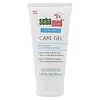What's inside
What's inside
 Key Ingredients
Key Ingredients

 Benefits
Benefits

 Concerns
Concerns

 Ingredients Side-by-side
Ingredients Side-by-side

Water
Skin ConditioningNiacinamide
SmoothingButylene Glycol
HumectantEnantia Chlorantha Bark Extract
Skin ConditioningOleanolic Acid
Skin ConditioningEthylhexyl Palmitate
EmollientSorbitan Oleate
EmulsifyingSorbitan Laurate
EmulsifyingMyristyl Malate Phosphonic Acid
Skin ConditioningGlycerin
HumectantIsononyl Isononanoate
EmollientHydroxyethyl Acrylate/Methoxyethyl Acrylate Copolymer
Cetearyl Alcohol
EmollientCoco-Glucoside
CleansingPEG-100 Stearate
Glyceryl Stearate
EmollientCetyl Palmitate
EmollientPhenoxyethanol
PreservativeEthylhexylglycerin
Skin ConditioningZinc PCA
HumectantPolyacrylate Crosspolymer-6
Emulsion StabilisingMagnesium Aspartate
Skin ConditioningZinc Gluconate
Skin ConditioningCopper Gluconate
Skin ConditioningSodium Acrylate/Sodium Acryloyldimethyl Taurate Copolymer
Emulsion StabilisingCaesalpinia Spinosa Gum
Skin ConditioningDisodium EDTA
Triethanolamine
BufferingWater, Niacinamide, Butylene Glycol, Enantia Chlorantha Bark Extract, Oleanolic Acid, Ethylhexyl Palmitate, Sorbitan Oleate, Sorbitan Laurate, Myristyl Malate Phosphonic Acid, Glycerin, Isononyl Isononanoate, Hydroxyethyl Acrylate/Methoxyethyl Acrylate Copolymer, Cetearyl Alcohol, Coco-Glucoside, PEG-100 Stearate, Glyceryl Stearate, Cetyl Palmitate, Phenoxyethanol, Ethylhexylglycerin, Zinc PCA, Polyacrylate Crosspolymer-6, Magnesium Aspartate, Zinc Gluconate, Copper Gluconate, Sodium Acrylate/Sodium Acryloyldimethyl Taurate Copolymer, Caesalpinia Spinosa Gum, Disodium EDTA, Triethanolamine
 Reviews
Reviews

Ingredients Explained
These ingredients are found in both products.
Ingredients higher up in an ingredient list are typically present in a larger amount.
Glycerin is already naturally found in your skin. It helps moisturize and protect your skin.
A study from 2016 found glycerin to be more effective as a humectant than AHAs and hyaluronic acid.
As a humectant, it helps the skin stay hydrated by pulling moisture to your skin. The low molecular weight of glycerin allows it to pull moisture into the deeper layers of your skin.
Hydrated skin improves your skin barrier; Your skin barrier helps protect against irritants and bacteria.
Glycerin has also been found to have antimicrobial and antiviral properties. Due to these properties, glycerin is often used in wound and burn treatments.
In cosmetics, glycerin is usually derived from plants such as soybean or palm. However, it can also be sourced from animals, such as tallow or animal fat.
This ingredient is organic, colorless, odorless, and non-toxic.
Glycerin is the name for this ingredient in American English. British English uses Glycerol/Glycerine.
Learn more about GlycerinPhenoxyethanol is a preservative that has germicide, antimicrobial, and aromatic properties. Studies show that phenoxyethanol can prevent microbial growth. By itself, it has a scent that is similar to that of a rose.
It's often used in formulations along with Caprylyl Glycol to preserve the shelf life of products.
Water. It's the most common cosmetic ingredient of all. You'll usually see it at the top of ingredient lists, meaning that it makes up the largest part of the product.
So why is it so popular? Water most often acts as a solvent - this means that it helps dissolve other ingredients into the formulation.
You'll also recognize water as that liquid we all need to stay alive. If you see this, drink a glass of water. Stay hydrated!
Learn more about Water